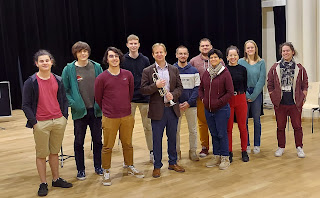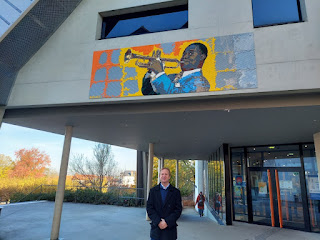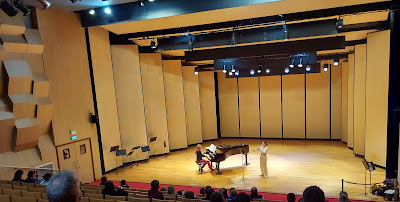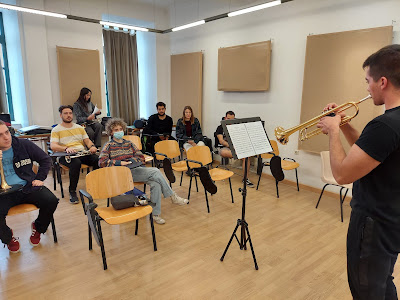Synopsis
Singers
have a well-codified system of vocal phonation modes that may parallel sound
production for the brass player. Study of these modes may help brass players
produce sounds that are more resonant and more colorful.
Introduction
Brass
players and singers have much in common. For both groups, an actual part of the
human body produces the sound. For the brass player, it is the lips; for the
singer, the vocal cords. In both cases, flesh is activated by the flow of air,
and the faster the oscillation of that tissue, the higher the pitch. In both
cases, the diaphragm, thoracic, and abdominal muscles modify the respiratory
system's natural process. The sound of a
singer's vocal cords vibrating prior to passing through the oral cavity sounds
quite a bit like a brass player buzzing their mouthpiece. (Steenstrup, 18)
Singers
have a long and robust tradition in exploring the science of sound production,
a tradition that in some ways is superior to what we know about sound production
in brass instruments. For today's blog article, I would like to focus on some
basic ideas of vocal sound production, and how they might inform our thoughts
about brass playing. In particular, I would like for brass players to explore
how they may be able to develop and explore new tone colors, in a similar
manner to how singers do this with vocal phonation modes.
For
starters, four principles regarding sound production for singers should be
noted:
1.
The vocal cords are a singer's reed, and they consist of the thyroarytenoid
muscle and a membrane that covers it.
2.
Adduction is the "closing" movement of the vocal folds, coming
together.
3.
Abduction is the "opening" movement of the vocal folds, separating apart.
4.
The sound quality (timbre) is largely derived from the balance of opening and
closing phases. If the closing phase is longer
than the opening phase, the sound will be brighter (richer in upper harmonics).
If the opening phase is longer than the closing phase, the sound will be darker
(lacking in upper harmonics). (For
a more in-depth explanation of harmonics and tone color, check out the video I made last year on this subject.)
Process of Phonation
The
phonation process involves the opening and closing phases of the vocal cords in
response to the air, in a manner quite similar to that of the brass player’s
lips. Since I am not a singer, allow me to directly reference a well-respected
vocal pedagogy source: Agostoni writes:
“During
the expiration the vocal cords are drawn together by the adductor muscles; the
subglottic pressure pushes them apart, while their elastic recoil and the
decrease of the lateral pressure due to the increase in kinetic pressure
(Bernoulli principle) close them again, thus generating a periodic flow.” (Agostini, 105–106)
Types of Phonation
Vocal
phonation is the process by which the vocal folds produce sound. Vocal
pedagogues know that the timbre of a singer’s voice is determined by the type
of phonation they employ. In the standard voice pedagogy textbook, The Science of the Singing Voice (1987),
Johan Sundberg introduced four types of phonation: breathy, pressed, flow, and
neutral. Since that time, other modes have been described, such as creak
phonation and falsetto phonation.
Breathy Phonation
Breathy
phonation is when there is a higher airflow (and according to Boyle’s law,
inversely, lower air pressure) and a low
adduction force. A great deal of air passing between the vocal folds that are
held together by a smaller adduction force means that the vocal folds likely do
not come completely together. This causes air to pass over the vocal folds that
is not used for vibration, but rather, is heard as noise. Therefore, the
unvibrated “noise” is perceptible in the sound quality, leading to a “breathy”
timbre. This timbre of breathing phonation has a lower intensity of the upper
harmonics.
Substituting
"lips" for "vocal cords," and keeping the air in common, we
can conjecture a brass playing equivalent of breathy phonation. Indeed, brass
players get an airy sound, lacking in upper harmonics, when lips do not come
completely together. Said another way, an airy sound may be the result of a
lack of muscular contraction of the lip muscles and/or an aperture that is too
large.
My
friend and former University of Kentucky trumpet professor Vince DiMartino sometimes
uses the term "blow-by" to describe this phenomenon for trumpet
players -- Air that passes between the lips unvibrated and is heard as noise.
It would seem to me that the “DiMartino Blow-by” and traditional vocal breathy phonation have much in common.
Pressed Phonation
Another
vocal phonation mode is pressed phonation. If the vocal cords are pressed
together with a high adduction force, combined with a higher air pressure, the
closing phase is longer than the opening phase, which would result in a
stronger intensity of the upper harmonics, which may be perceived as a
"strident" or "bright" sound.
The
brass playing equivalent of pressed phonation could be considered to be the
strident sound, strong in upper harmonics, that results from the combination of
lips that are pressed very tightly together, with high air pressure.
Flow Phonation (also
called Resonant Phonation)
Flow
phonation is the most resonant method of vocal phonation. Characteristics of
flow phonation include high airflow, and a high but balanced subglottal
pressure. Flow phonation is the most desirable method of singing and results in
a balanced spectrum of harmonics.
The
brass playing equivalent to flow phonation could be when airflow and lips are
working together, perfectly in balance, to produce the most resonant sound
quality.
Other Modes of Phonation
Vocal
pedagogues also describe other modes of vocal phonation. Creak phonation is
when there is a strong adduction force but at a very low frequency; this is the
result of irregular oscillation. This is also known as “vocal fry.” Falsetto
phonation is where the vocal folds are stretched and the vibrating surface is
quite thin; this results in much higher pitches. (I’m not sure if there would
be a direct equivalent of this phonation for brass players, but it sure would
be nice if there was a quick way to pop up the octave!)
Changing Colors
While
“flow phonation” may be the most ideal method for producing a resonant sound,
singers may intentionally use other modes of phonation to change their vocal
color, for expressive purposes. A singer may use breathy phonation for a
breathy, intimate timbre. A singer may use a pressed phonation to achieve a
tense, strident sound to convey anger.
Similarly,
while brass players should also strive for physical efficiency and their most
resonant sound production, they should also explore methods for producing a
variety of tone colors. Changes in airflow, air pressure, and adduction force
can also yield changes in a brass player’s timbre. For example, a jazz trumpet
player may purposely allow some air to enter their sound to obtain a more
diffused timbre. Conversely, a brass player may press their lips together with
a high adduction force in order to create more upper harmonics in their timbre.
Changing to Stay The
Same
Another
important thing brass players can learn from singers is the importance of
changing to stay the same. Since the amount of air remaining in the lungs is
constantly decreasing over the course of a musical phrase, the relationship
between airflow and the vocal cord tension is constantly changing. Agostini
writes,
“To produce a pitch of constant loudness and pitch the subglottic
pressure must increase, while the vocal cord tension must decrease in order to
keep the pitch constant.”
For
brass players, a takeaway is that maintaining a note of the same volume and
pitch is not a static process, but rather one in which we must change in order
to stay the same.
Focus on the Music, Not
on the Muscles
One
conclusion that could be drawn from this information is that more focus should
be put on the musician's specific control of their musculature -- but nothing
could be further from the truth. Singers should not attempt to directly and mechanically
control the stiffness and tension of their vocal cords. In the same book that
codifies vocal phonation modes, Sundberg writes,
"We
do not need to bother about the extremely complicated maneuvers we perform. We
just perform them unconsciously, and what catches our attention is the end
result, the sound." (Sundberg, The
Science of Singing Voice, 18)
In
a similar way, brass musicians need not worry about the specific musculature
involved when they are performing.
Rather, this information can be used as a diagnostic tool to address and
correct problems.
Good Playing is Easy
My
teacher Keith Johnson would often say, “Good playing is easy,” and I believe the
singer’s concept of flow phonation reinforces this notion. Since vocal flow
phonation is achieved through less
contraction of the laryngeal muscles and less
air pressure, it could also be described as the type of sound production that
requires the least physical effort. Said another way, the most resonant sound
quality may best be achieved through a method that is also the easiest from a
physiological and aerodynamic basis.
For Future Researchers
While
these phonation modes have been well researched by vocal pedagogues, more work
is needed in the area of brass pedagogy. I believe there are many parallels
between singing and trumpet playing, and this is a golden opportunity for
future researchers. Ambitious and creative doctoral students who may be reading
this blog may find this an area not yet adequately explored by brass researchers, and
quite possibly a great topic for future dissertation and scholarly article
work.
The author would like to
extend a special thank you to Dr. Elizabeth Arnold, Associate Professor of
Voice in the University of Kentucky School of Music, for her contribution to and
feedback on this article.
 Jason Dovel is associate professor of trumpet at the University of Kentucky and a Yamaha Performing Artist. He is host of the annual UK Summer Trumpet Institute held every June in Lexington, KY (USA).
Jason Dovel is associate professor of trumpet at the University of Kentucky and a Yamaha Performing Artist. He is host of the annual UK Summer Trumpet Institute held every June in Lexington, KY (USA).
Sources/For Future Research
If
you'd like to take a look at what vocal cords look like "in action,"
check out this YouTube video: https://www.youtube.com/watch?v=D6mLc9gOgVA
Modes
of Phonation Website: https://www.vocalovertones.com/modes-of-phonation/
Types
of Phonation (With cool sound files for examples):
https://www.ims.uni-stuttgart.de/institut/arbeitsgruppen/ehemalig/ep-dogil/EGG/page10.htm
Dovel,
Jason, Exploring Trumpet Tone Color, https://youtu.be/94E5HewSWQY
Agostini,
E and Ambrogio, G. Sant, The Respiratory
Muscles, Mechanics, and Neural Control, 1970.
Proutskova,
Rhodes, Crawford, and Wiggins, "Breathy, Resonant, Pressed - Automatic
Detection of Phonation Mode from Audio Recordings of Singing," Journal
of New Music Research (2013)
Steenstrup,
Kristian, Teaching Brass (2nd revised
edition), Royal Academy of Music, Aarhus, 2007.
Sundberg,
Johan, The Science of the Singing Voice,
1987.
 Jason Dovel is associate professor of trumpet at the University of Kentucky and a Yamaha Performing Artist. He is host of the annual UK Summer Trumpet Institute held every June in Lexington, KY (USA).
Jason Dovel is associate professor of trumpet at the University of Kentucky and a Yamaha Performing Artist. He is host of the annual UK Summer Trumpet Institute held every June in Lexington, KY (USA).






































